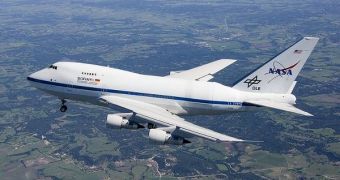The year 2010 will see the commissioning of the world's most powerful and advanced airborne telescope, capable of watching targeted events from the most advantageous positions possible at all times. As opposed to ground-based telescopes, which are restrained to their geographical locations no matter what, the Stratospheric Observatory for Infrared Astronomy (SOFIA) will be able to fly to any location its operators see fit. The amazing instrument is mounted inside a a Boeing 747SP wide-body aircraft, which can fly high into the stratosphere, at altitudes up to about 45,000 feet (13,800 meters).
“SOFIA is set to achieve some spectacular science. For instance, this telescope will help us figure out how planets form and how our own solar system came to be,” project scientist Pamela Marcum explains, quoted by PhysOrg. The 17-ton, nine-foot wide telescope will have an impressive advantage over other observatories when it begins its work, as it will be able, for example, to be scrambled into the air shortly before stellar occultations begin. During these events, an object such as an exoplanet moves in front of a star, and temporarily blocks a part of or all of its light.
Observations taken in these instances could easily help astronomers discover some key features about the two celestial bodies, but the thing is that the science will be performed at locations that are maybe not suitable for the placement of a full-scale observatory on the ground. Weather conditions over the area could only work for a short amount of time, so SOFIA will be able to take full advantage of that. Additionally, the high altitudes its carrier aircraft is capable of flying to will ensure that the observatory will go above clouds, ensuring a good view.
“SOFIA will be able to locate the 'planetary snowline,' where water vapor turns to ice in the disk of dust and gas around young stars. That's important because we think that's where gas giants are born. The most massive planetary cores are fashioned [around the snowline] because conditions are best for rock and ice to build up. Once a large enough core forms, its gravity becomes strong enough to hold on to gas so more hydrogen and helium molecules can 'stick.' Then these large cores can grow into gas giants like Jupiter and Saturn. Otherwise, they remain as smaller rock-ice planets. SOFIA will also be able to pinpoint where basic building blocks like oxygen, methane, and carbon dioxide2 are located within the protoplanetary disk” Marcum says.

 14 DAY TRIAL //
14 DAY TRIAL //